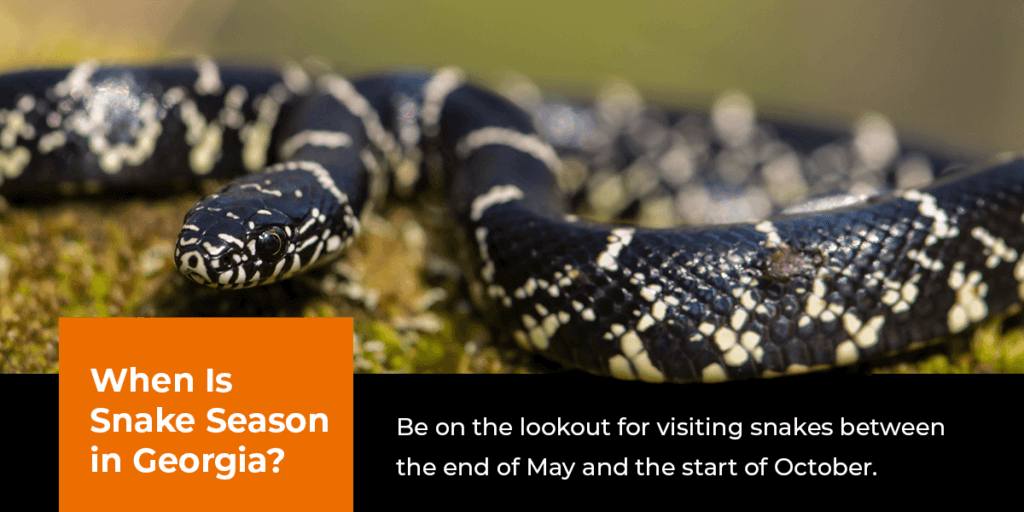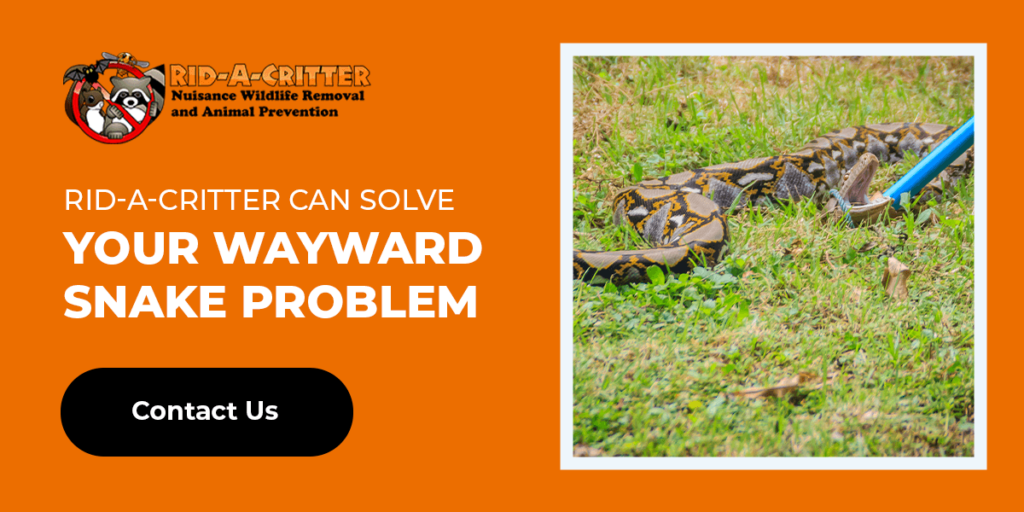Snakes signify a thriving ecosystem, so while it’s fantastic that Georgia has so many, you’d likely prefer them to stay outside and away from your family. In this guide, you’ll learn about the most common venomous and non-venomous snakes found in Georgia, how to identify them and what to do if you find one in your home.
What Are the Most Common Snakes Found in Georgia?
Of the 47 known snake species that inhabit Georgia, only a handful regularly enter homes, and even they are infrequent visitors. Most snakes are reclusive and stick to creeks and wooded areas for hunting and breeding. Thankfully, all the most common snakes found in Georgia homes are non-venomous.
1. Eastern Rat Snake
Eastern rat snakes are Georgia’s most prominent snake species, found statewide. They usually measure between 3.5 and 7 feet long and have shiny black scales with a white or pale yellow mottled underbelly. When threatened, Eastern rat snakes sometimes shake their tails in a defensive display, leading many people to confuse them for rattlesnakes.
2. Black Racer
True to their name, black racers have smooth, black scales as adults, while juveniles have yellow, gray and red spots along their backs. Their bellies are usually dark gray or black, unlike their rat-snake lookalikes. Black racers range from 1.9 to 5.7 feet long and move at 4 miles per hour — the speed of an adult human walking briskly. They also mimic the rattlesnake by quivering their tails, bearing their fangs and coiling up to look intimidating.
3. Brown Snake
Also known as DeKay’s brown snake, these petite reptiles eat worms, snails and slugs, making them excellent pest-controlling houseguests — if they stay in the garden. They are tiny compared to rat and black racer snakes, measuring 9 to 13 inches long. They have brown or tan scales with a faint checkered pattern that’s often hard to see because they’re so small.
4. Eastern King Snake
Eastern king snakes measure 3 to 5 feet long and live throughout Georgia. They are generally smooth, shiny and black with white or light yellow banding. However, a subspecies called the black king snake, found in Northwest Georgia, is fully black with no banding. They have small, short heads, prefer to live near water and mimic the rattlesnake’s tail vibrations when threatened.
When Is Snake Season in Georgia?
You’re most likely to find a reptilian guest in your home during late spring and summer, so be on the lookout for visiting snakes between the end of May and the start of October.
Snakes are cold-blooded, so they get their body heat from their environment, unlike warm-blooded animals that regulate their temperature internally. Snakes take refuge in shaded areas to cool down in hot, sunny weather. Since most Georgia homes have air conditioning, they’re an inviting spot for snakes to slither in and rest.

Does Georgia Have Any Venomous Snakes?
Of the 47 snake species in Georgia, only seven are venomous, and you’re unlikely to encounter them in your home. Even if you stumble across a venomous snake, they generally don’t attack unless provoked, so it’s safest to take a picture of it from a distance for identification and avoid it. Never try to handle snakes yourself, as even some non-venomous types can give a nasty bite prone to infection if pushed to self-defense.
What Venomous Snakes Are in Georgia?
The seven venomous snakes found in Georgia are the Eastern and Florida cottonmouth snakes, the copperhead snake, the reclusive Eastern coral snake and three rattlesnake species — the timber, the Eastern diamondback and the pygmy rattlesnake. The three most commonly encountered venomous snakes in the state are rattlesnakes, copperheads and cottonmouths.
1. Rattlesnakes
While timber rattlesnakes mainly inhabit North Georgia and the Coastal Plain and diamondback rattlesnakes mostly live in South Georgia, pygmy rattlesnakes thrive throughout the state.
- Timber rattlesnakes: These snakes, also called canebrake rattlesnakes or American vipers, average between 2.5 and 5 feet in length and have light grayish-brown scales and dark bands across their bodies. They have a segmented rattle that is sometimes black.
- Diamondback rattlesnakes: These are the largest venomous snakes in North America. They can grow up to 8 feet long and weigh an average of 10 pounds. They have dull, dark gray or olive green scales, distinct diamond-shaped markings on their backs and a large rattle on the tips of their tails.
- Pygmy rattlesnakes: These little snakes are an average of 1.5 feet long, have light gray or brown scales with dark black spots and ward off threats with a small rattle on their tail tips.
2. Copperheads
Copperhead snakes occur throughout Georgia, though they are rare in the state’s southeastern corner. They are usually around 3 feet long and have tan, gray, pinkish or brown scales with blobby or hourglass-shaped dark brown patterns on their backs that are wider on the snake’s sides and narrower near the top of their back. People often confuse DeKay’s brown snakes for baby copperheads, but you can tell them apart by the distinct patterns, which copperheads have and brown snakes don’t.
3. Cottonmouths or Water Moccasins
Cottonmouths, also known as water moccasins, are abundant in Georgia and live in almost all counties. Cottonmouths average between 2 and 4 feet long, though they can grow up to 6 feet long. They have olive or tan scales with dark brown banding that darkens to near-black as they mature, but their coloring can vary depending on where they live. Due to their similar appearance and preference for water, many people confuse cottonmouths for non-venomous banded water snakes. Cottonmouths are thicker than banded water snakes and have vertical pupils and triangular heads.
How Can You Identify Snakes in Georgia?
Learning how to identify a snake is essential for assessing its threat level and putting your mind at ease. If you get bitten, a health professional will ask which snake bit you so they can treat you accordingly. Once you’ve looked up information on Georgia snakes, follow these four steps when you come across a snake in your home:
- Assess its size, shape and coloring.
- Take note of any distinct physical features, like rattles or markings.
- Consult an online or printed field guide.
- Take a picture from a distance for experts to refer to.
How to Remove Snakes From Your Home
It is illegal to kill any native non-venomous snake in Georgia, so it is always best to humanely remove any slithering houseguests. However, for safety reasons, you should never approach a venomous snake, so contact your local animal removal service to take care of it for you.
If you’re 100% sure the snake is non-venomous and you cannot reach animal removal experts, you can:
- Close any doors leading to other rooms to prevent it from moving farther into your home.
- Gently sweep the snake outside with a broom if it’s already close to an exit.
- Contain the snake in a plastic container and bring it outdoors.
- Use a thick towel or gardening gloves to pick the snake up and release it outside.
Prevention is always better than cure, so consider hiring a snake exclusion service to seal crevices, cracks and gaps in your home’s exterior for peace of mind and maximum safety.
Rid-A-Critter Can Solve Your Wayward Snake Problem
Trained professionals can quickly and easily differentiate between a venomous and a non-venomous snake, while homeowners may confuse a cottonmouth with a harmless rat snake and put themselves in danger. Always reach out to a reputable wildlife removal company to handle any snakes you find in your home.
Rid-A-Critter’s experienced, expertly trained team of licensed professionals can efficiently remove any intruding snake from inside your Georgia or Alabama home. Be safe and contact us to get help with unwanted snakes in your home or request a quote online today to humanely protect your home from animal invasions.



